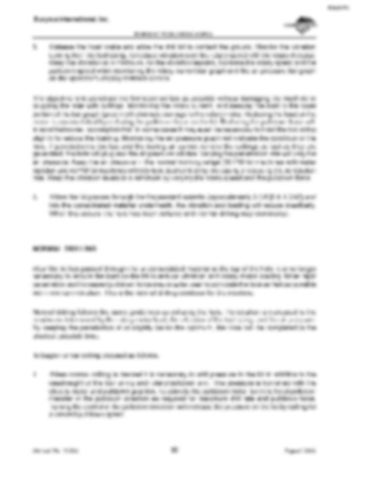BI616959
Bucyrus International, Inc. 59HR ELECTRIC BLAST HOLE DRILL
5.
Release the hoist brake and allow the drill bit to contact the ground. Monitor the vibration coming from the tool string. To reduce vibration slow the rotary speed with the rotary rheostat. Keep the vibration to a minimum. As the vibration lessens, increase the rotary speed and the pulldown speed while monitoring the rotary current bar graph and the air pressure bar graph on the operator’s display terminal screen.
The objective is to penetrate the formation as fast as possible without damaging the machine or plugging the hole with cuttings. Monitoring the rotary current, and keeping the load in the lower portion of the bar graph (green) will eliminate damage to the rotary motor. Reducing the load on the motor is accomplished by reducing the pulldown force on the bit. Reducing the pulldown force will, in most instances, accomplish this. In some cases it may even be necessary to hoist the tool string slightly to reduce the loading. Monitoring the air pressure graph will indicate the condition of the hole. If penetration is too fast and the bailing air cannot remove the cuttings as fast as they are generated, the hole will plug and the air pressure will rise. Varying the penetration rate will vary the air pressure. Keep the air pressure in the normal working range (30 PSI for machines with water injection and 40 PSI for machines with dry-type dust control) by increasing or reducing the penetration rate. Keep the vibration levels to a minimum by varying the rotary speed and the pulldown force. 6.
When the bit passes through the fragmented material (approximately 3-5 ft [0.9-1.5 M]) and into the consolidated material underneath, the vibration and loading will reduce drastically. When this occurs, the hole has been collared and normal drilling may commence.
NORMAL DRILLING After the bit has passed through the unconsolidated material at the top of the hole, it is no longer necessary to reduce the load on the bit to reduce vibration and rotary motor loading. More rapid penetration and increased pulldown force may now be used to complete the hole as fast as possible with minimum vibration. This is the normal drilling condition for the machine. Normal drilling follows the same guidelines as collaring the hole. Penetration is increased to the maximum determined by the rotary motor load, the vibration of the tool string, and the air pressure. By keeping the penetration at or slightly below the optimum, the hole can be completed in the shortest possible time. To begin normal drilling proceed as follows: 1.
When normal drilling is desired it is necessary to add pressure to the bit in addition to the deadweight of the tool string and rotary/pulldown unit. This pressure is furnished with the electric motor and pulldown gearbox. To activate the pulldown motor, turn the hoist/pulldown rheostat in the pulldown direction as required for maximum drill rate and pulldown force. Turning the control in the pulldown direction will increase the pressure on the bit by calling for a desired pulldown speed.
Manual No. 10425
88
August 2006


